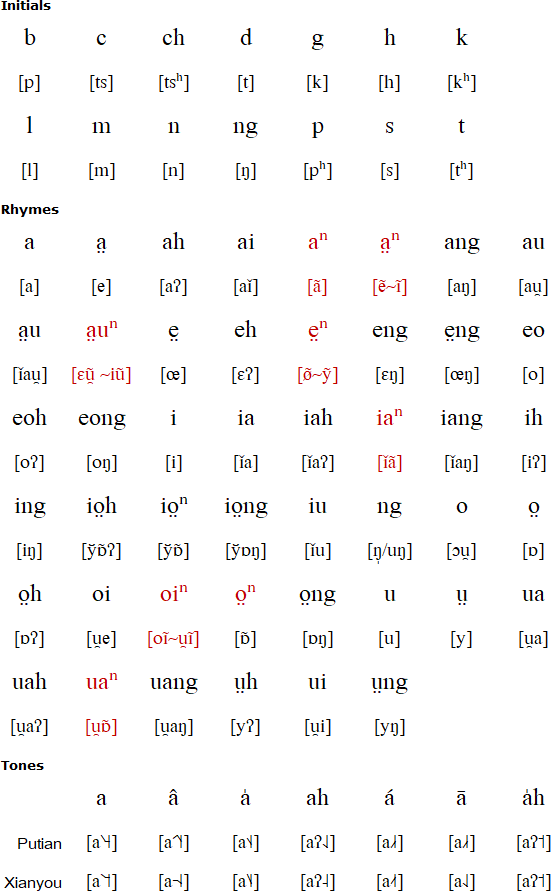Puxian is a variety of Min Chinese spoken by about 2.6 million people mainly in eastern parts Fujian Province in the south east of China. It is spoken particularly in Putian (莆田) and Xianyou (仙游) cities, in parts of Fuzhou (福州) and Quanzhou (泉州), and also in Shacheng town (沙埕镇), Fuding city (福鼎) in the north east of Fujian. There are Puxian speakers in Malaysia, Indonesia and Singapore as well.
Puxian is known as Pu-xian, Puxian Min, Púxiān huà / Pô-sing-gṳ̂ (莆仙语), or Xinghua, Hinghwa, Xīnghuà yǔ / Hing-hua̍-gṳ̂ (兴化语). The name Puxian combines the Pu (莆) from Putian (莆田) with the Xian (仙) from Xianyou (仙游). It belongs to the Min (闽语) branch of the Sinitic languages and originated from Minnan (Southern Min), but developed separately after 979 AD as the region as administered separately and the language developed in isolation from other Minnan varities, and was heavily influenced by Min Dong (Eastern Min). As a result Puxian is not mutually intelligible with either Minnan or Min Dong varieties and could be considered a separate branch of Min.
Puxian can be written using a Romanization system known as Hing-hua̍ báⁿ-uā-ci̍ (興化平話字), which was developed by the American missionary William N. Brewster (蒲鲁士) in the 1890s. It was used to produce Puxian translations of the Bible and other religious works, and a newspaper, which ceased publication in 1950.

The consonants in red are only used in Xianyou dialect.
Download alphabet charts for Puxian in PDF or Excel format.
Tai̍-che̤ ū Dō̤, Dō̤ gah Siō̤ng-Da̤̍ dó̤ng-cāi, Dō̤ cuh sī Siō̤ng-Da̤̍. Ca̤̍ Dō̤ ta̍i-che̤ gah Sio̤ng-Da̤̍ dó̤ng-cāi. Māng-beo̍h sī ciā da̤u̍h I cho̤̍ ē; hang pī cho̤̍, beo̍ seo̍h-ā̤uⁿ ng-sī ciā da̤u̍h I cho̤̍ ē.
太初有道,道佮上帝同在,道就是上帝。這道太初佮上帝同在。萬物是借著伊造兮,含被造兮,無一樣呣是借著伊造兮。
In the beginning was the Word, and the Word was with God, and the Word was God. The same was in the beginning with God. All things were made by him; and without him was not any thing made that was made. (John 1:1-3)
Information about Puxian
http://en.wikipedia.org/wiki/Pu-Xian_Min
http://zh.wikipedia.org/wiki/莆仙話
http://www.ethnologue.com/language/cpx
Dungan, Cantonese, Fuzhounese, Gan, Hakka, Jian'ou, Mandarin, Puxian, Shanghainese, Taiwanese, Taiwanese Hakka, Teochew, Weitou, Wenzhounese, Xiang
Written Chinese: Oracle Bone Script, Simplified characters, Bopomofo, Types of characters, Structure of written Chinese, Evolution of characters, How the Chinese script works, Xiao'erjing, General Chinese
Spoken Chinese: Mandarin, Dungan, Wu, Shanghainese, Wenzhounese, Yue, Cantonese, Weitou, Min, Jian'ou, Taiwanese, Teochew, Fuzhounese, Puxian, Hakka, Xiang, Gan, How many people speak Chinese?
Other Chinese pages: Chinese numbers (數碼) | Chinese classifiers (量詞) | Electronic dictionaries | Chinese links | Books: Chinese characters and calligraphy | Cantonese | Mandarin, Shanghainese, Hokkien and Taiwanese
Akkadian Cuneiform, Ancient Egyptian (Demotic), Ancient Egyptian (Hieratic), Ancient Egyptian (Hieroglyphs), Chinese, Chữ-nôm, Cuneiform, Japanese, Jurchen, Khitan, Linear B, Luwian, Mayan, Naxi, Sawndip (Old Zhuang), Sui, Sumerian Cuneiform, Tangut (Hsihsia)
Page last modified: 15.03.23
[top]
You can support this site by Buying Me A Coffee, and if you like what you see on this page, you can use the buttons below to share it with people you know.

If you like this site and find it useful, you can support it by making a donation via PayPal or Patreon, or by contributing in other ways. Omniglot is how I make my living.
Note: all links on this site to Amazon.com, Amazon.co.uk
and Amazon.fr
are affiliate links. This means I earn a commission if you click on any of them and buy something. So by clicking on these links you can help to support this site.
[top]